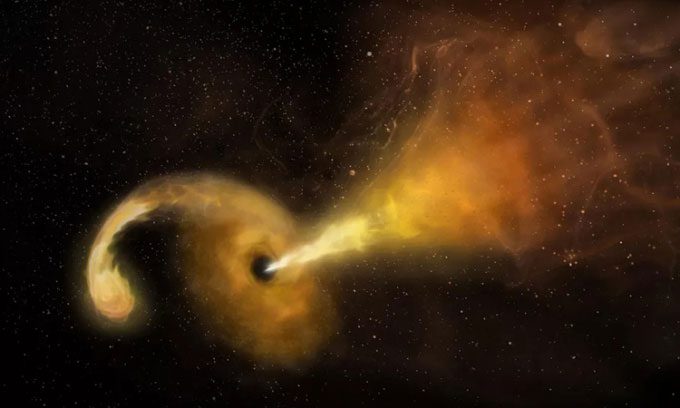Two high school interns at Harvard have found evidence of a “star-eating” black hole using data from the 1980s.
When a star comes too close to a black hole, the black hole’s immense gravitational pull tears the star apart, stretching its material into thin strands and pulling it toward itself. This chaotic process generates a powerful burst of light known as a tidal disruption event (TDE).
Since the first discovery four decades ago, astronomers have confirmed around 100 instances of black holes devouring stars, mostly by scanning the sky for visible light or X-rays emitted from TDEs.

Simulation of a supermassive black hole tearing apart a star and emitting TDE. (Image: NRAO/AUI/NSF/NASA)
This new discovery is particularly special: partly because it is a rare case confirming the presence of a TDE through radio waves, and partly because it was made by high school students during an internship at Harvard University.
Specifically, while studying a cache of old data collected in the 1980s by the Very Large Array (VLA) radio telescope at the Karl G. Jansky National Radio Astronomy Observatory in New Mexico, two teenagers, Ginevra Zaccagnini and Jackson Codd, from a high school in Massachusetts, noticed a light source named J1533 + 2727 (discovered in the mid-1990s) had significantly faded in 2017.
They reported this finding to scientists, who then used the 90-meter radio telescope at the Green Bank Observatory in West Virginia to conduct additional observations. The results showed that J1533 + 2727 had dimmed over 500 times from its brightest state.
Further analysis of the light source suggests that it could be a TDE, caused by a supermassive black hole located 500 million light-years from Earth as it devoured a star passing by.
“This is the first discovery of a potential TDE in the relatively nearby universe. It suggests that tidal disruption events may be more common than we previously thought,” said astronomer Vikram Ravi from the California Institute of Technology.
The new discovery was presented at the 239th meeting of the American Astronomical Society on January 10.





















































